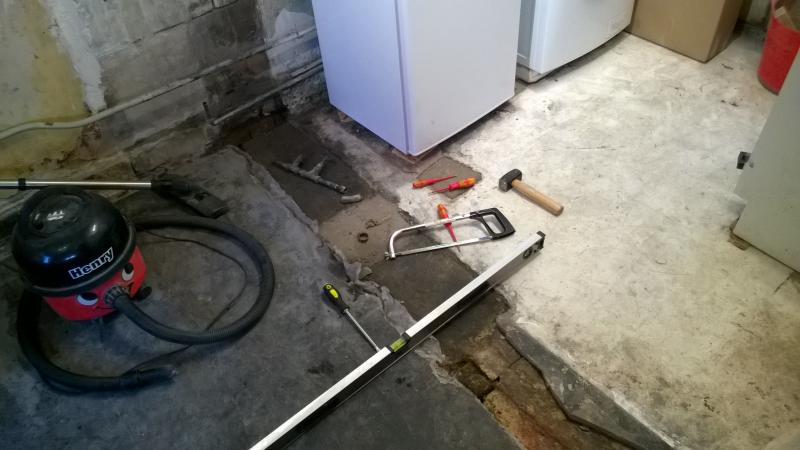I am in the process of renovating my kitchen and my next task is to sort the flooring out. I have just had the wall knocked through between the kitchen and utility room to create one larger kitchen, so I now have two separate concrete floors to join up.
The concrete floor in the kitchen was replaced within the last couple of decades (before I moved in) and has a DPM under it, about 100mm of concrete and then about 50mm screed on top. It is all level and in good condition and don’t plan to do anything with it.
The utility room floor is part of a 1930’s extension, it has no DPM and although appears pretty solid it is not level at all. At some point (possibly when the kitchen floor was replaced) it looks like a thin layer of screed was put over the top possibly to try and even it out. Either they didn’t do a very good job or the floor has sunk in places since they did it, although there are no cracks anywhere that would suggest it has sunk.
I am planning to use self-levelling compound and liquid DPM on the utility floor in order to waterproof it, get a level floor and bring it up to the same height as the existing kitchen floor.
The photo below shows what I am starting with, the kitchen floor on the left and utility floor on the right. There is a section between the two floors where the wall used to be. I currently have no intention of pulling up the stonework from the old wall which sits just below the floor surface and was planning to just self-level over this along with the rest of the utility floor.
I have listed below the plan for levelling the floor (based on the stickies on this forum) along with some questions, and would appreciate any advice or suggestions on how I am going about things.
1. Planning to use concrete repair mortar over a large part of the floor, including the area over the old wall footings, in order to increase the height of the floor (several cm lower in some areas) – or would a deep fill self-levelling compound be better? Should I just use this to bring the footing section up to the existing level of the utility floor?
2. Clean the existing floor ready for priming – it appears to have been painted in the past (or could be old tile adhesive?), how important is it to remove paint before priming or can I leave it as it is?
3. Prime floor
4. Apply latex self-levelling compound (~5mm depth)
5. Apply liquid DPM to floor
6. Intend to try and bed the existing sheet DPM of the kitchen floor into the liquid DPM so that the DPM is continuous
7. Apply final water based self-levelling compound to bring up to existing kitchen floor level (~5mm depth)
8. Is 5mm depth for each of the compound applications ok or should I aim for more/less?
The concrete floor in the kitchen was replaced within the last couple of decades (before I moved in) and has a DPM under it, about 100mm of concrete and then about 50mm screed on top. It is all level and in good condition and don’t plan to do anything with it.
The utility room floor is part of a 1930’s extension, it has no DPM and although appears pretty solid it is not level at all. At some point (possibly when the kitchen floor was replaced) it looks like a thin layer of screed was put over the top possibly to try and even it out. Either they didn’t do a very good job or the floor has sunk in places since they did it, although there are no cracks anywhere that would suggest it has sunk.
I am planning to use self-levelling compound and liquid DPM on the utility floor in order to waterproof it, get a level floor and bring it up to the same height as the existing kitchen floor.
The photo below shows what I am starting with, the kitchen floor on the left and utility floor on the right. There is a section between the two floors where the wall used to be. I currently have no intention of pulling up the stonework from the old wall which sits just below the floor surface and was planning to just self-level over this along with the rest of the utility floor.
I have listed below the plan for levelling the floor (based on the stickies on this forum) along with some questions, and would appreciate any advice or suggestions on how I am going about things.
1. Planning to use concrete repair mortar over a large part of the floor, including the area over the old wall footings, in order to increase the height of the floor (several cm lower in some areas) – or would a deep fill self-levelling compound be better? Should I just use this to bring the footing section up to the existing level of the utility floor?
2. Clean the existing floor ready for priming – it appears to have been painted in the past (or could be old tile adhesive?), how important is it to remove paint before priming or can I leave it as it is?
3. Prime floor
4. Apply latex self-levelling compound (~5mm depth)
5. Apply liquid DPM to floor
6. Intend to try and bed the existing sheet DPM of the kitchen floor into the liquid DPM so that the DPM is continuous
7. Apply final water based self-levelling compound to bring up to existing kitchen floor level (~5mm depth)
8. Is 5mm depth for each of the compound applications ok or should I aim for more/less?


